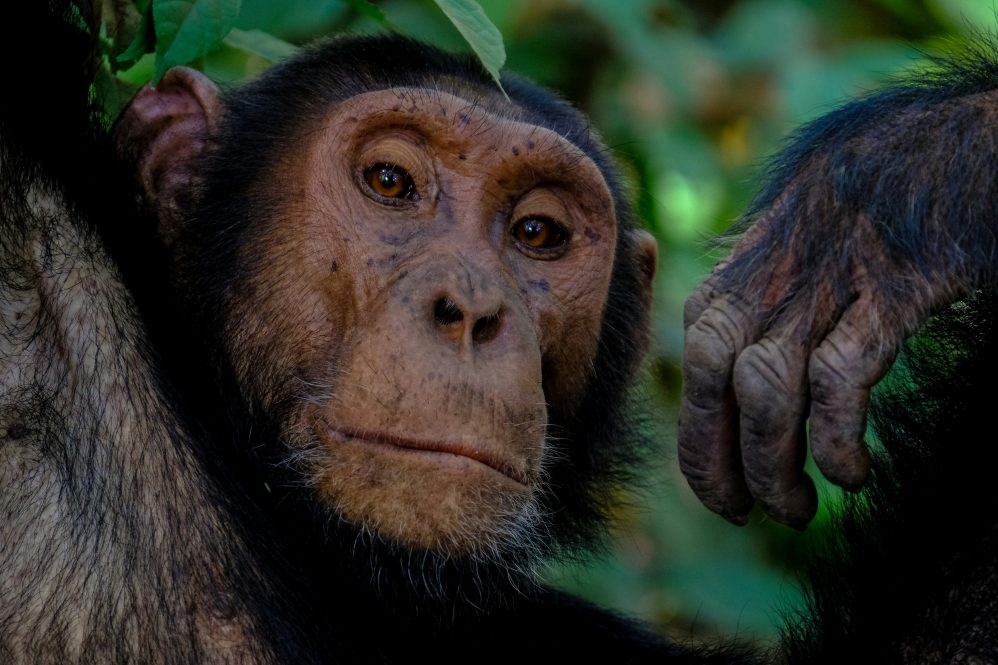For the first time, researchers have assembled a complete “end-to-end” reference genome for the sex chromosomes of five great ape species and one lesser ape species. The findings shed light on the evolution of sex chromosomes and inform understanding of diseases related to genes on these chromosomes in both apes and humans.
Members of the Telomere-to-Telomere (T2T) Consortium, a team of over 100 researchers from institutions around the world, collaborated for this landmark effort. Their findings were published June 16 in the journal Nature.
One of the paper’s first authors, Gabrielle Hartley, is a research associate in the lab of Rachel O’Neill at the University of Connecticut. Hartley was part of O’Neill’s lab when it helped propel the T2T Consortium to its first major breakthrough – the complete sequencing of the human genome – in 2022.
Then in August 2023, the consortium announced it had fully sequenced the human Y chromosome as well.
After that, says Hartley, “The question was, ‘What are we going to do next?’”
O’Neill, who is director of UConn’s Institute for Systems Genomics, has long specialized in sequencing repetitive genomes. This expertise was what allowed her lab to fill in the gaps left by the Human Genome Project – gaps which turned out to be populated with millions of repetitive, difficult-to-decipher fragments of DNA.
“Something I think a lot of people don’t realize when they’re thinking about DNA or a genome sequence is that really only 2% or so of our genome is genes,” Hartley explains. “A lot of it is just all this extra, repeated DNA.”
Building on this expertise, O’Neill’s lab joined the effort to sequence primate sex chromosomes, which are as notoriously repetitive as their human counterparts. The team was led by researchers at Pennsylvania State University, the National Human Genome Research Institute, and the University of Washington.
“We brought our experience in repeat analyses to the consortium to not only annotate large portions of these sex chromosomes, but to study repeat dynamics across these species,” O’Neill says.
Now, the researchers have complete reference genomes for chimpanzees, bonobos, gorillas, Bornean and Sumatran orangutans, and siamang gibbons. Since these are some of humans’ closest relatives, the findings have implications for understanding the health and evolution not just of primates, but of humans too.
“Before these sequences, we really weren’t able to get a good look at a lot of genes that only exist on the sex chromosomes,” Hartley says. “There’s reproduction genes, there’s even some immunity genes – and we just couldn’t understand them without having the sequence. This opens a lot of doors for comparative genomics and investigating what makes a human sequence different from any other ape sequence.”
Researchers compared the sequences of the ape chromosomes to the human X and Y chromosomes to understand their evolutionary histories. Like the human X and Y, the great ape Y chromosomes have far fewer genes compared to the X chromosomes. Researchers also used a computational method called alignment, which indicates regions of the chromosome that have stayed relatively the same over the course of evolution, revealing the effects of different evolutionary pressures on different parts of the genome.
Researchers found that over 90% of the ape X chromosome sequences aligned to the human X chromosome, showing that the X chromosomes have remained relatively unchanged over millions of years of evolution. However, only 14% to 27% of the ape Y chromosome sequences aligned to the human Y chromosome.
“The extent of the differences between the Y chromosomes of these species was very surprising,” says Kateryna Makova, a professor at Pennsylvania State University and leader of the study. “Some of these species diverged from the human lineage only 7 million years ago, which is not a lot of time in terms of evolution. This shows that the Y chromosomes are evolving very fast.”
Researchers are currently working to describe the entire genomes of these great ape species, but even alone, the X and Y chromosome sequences offer many insights, especially about the evolutionary forces on the Y chromosome that contribute to its rapid evolution.
One factor is that there is typically only one Y chromosome per cell, which leads to accumulating changes to the DNA sequence. Another evolutionary force, Makova says, is a phenomenon known as male mutation bias. Compared to egg production, sperm production involves more DNA replication. With each replication, there is a chance the DNA sequence changes. This affects all chromosomes but is particularly impactful for the Y chromosome.
Another potential factor is having a small population size, which can influence evolutionary rates. Not only do these ape species have limited populations in the wild, but the Y chromosomes are only present in half the population, further limiting the effective population size of this particular part of the genome.
“It’s important to remember that these great ape species are all endangered,” says Makova. “Not only can we learn about human evolution from these sequences, but we can apply what we know about their genomes and human genomes to better understand the biology and reproduction of these endangered species.”
“The methods developed to study these genomes provide a framework to study the genomes of other endangered species and, more importantly, apply genomic information to conservation management strategies,” says O’Neill.



